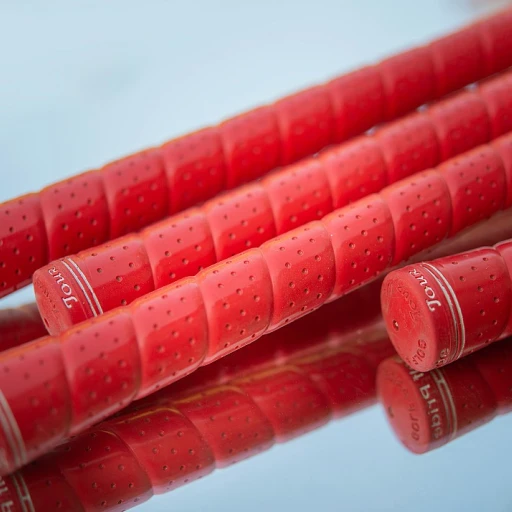
Understanding the 5 wood: what makes it unique?
The 5 wood: a distinct contender in your golf bag
The 5 wood often gets overshadowed by its flashier siblings like the driver or the irons, but it's essential to understand what makes this club so unique. Unlike your driver or your longer irons, the 5 wood combines remarkable accuracy with impressive distance.
The key attributes of the 5 wood that set it apart involve its loft and versatility. Most 5 woods have a loft angle ranging from 18 to 21 degrees, providing a balanced blend of lift and distance. This loft is often considered a sweet spot for golfers looking to gain precise control over their shots while still achieving substantial yardage.
Consider the design: the 5 wood typically has a larger clubhead compared to long irons, which helps in delivering a more consistent and forgiving strike. This larger head size aids golfers of all swing speeds in hitting the ball cleaner and achieving a good launch angle.
Features that complement your playing style
The shaft length and material of a 5 wood also play a significant role in its performance. Generally, 5 wood shafts are shorter than drivers, often around 42-43 inches, which makes them easier to control and more accurate. Additionally, modern technological advancements in shaft materials such as graphite provide greater flexibility and swing speed, accommodating both slower and faster swing speed golfers.
Take Dustin Johnson, for example. He showcases a powerful swing with a 5 wood, demonstrating its potential to cover distances efficiently. Similarly, Rory McIlroy's precision with this club highlights its utility for delivering accurate shots on the fairway.
Versatility meets performance
Fairway woods, particularly the 5 wood, fit snugly between fairway wood options and hybrids, making them a preferred choice for an array of situations on the course. Whether you're eyeing a second shot on a par 5 or navigating a tricky fairway bunker, the 5 wood gives you the flexibility to handle different lies and terrains.
Its versatility means you can easily hit long shots, some fairways, and even rough patches. The ability to control the ball's flight and make it land softly on the green makes the 5 wood invaluable for longer approach shots, thereby giving you an edge in precision shots.
To get the most out of your 5 wood, a few expert tips like tweaking your stance, adjusting your grip, and leveraging technology can offer significant improvements. Tools like Trackman can provide invaluable insights by analyzing data like ball speed, launch angle, and distance metrics, ultimately helping you master the art of using your 5 wood effectively. For more on maximizing your swing, check out these pro-level swing tips.
The science behind 5 wood distance
The physics of launching a 5 wood
The 5 wood isn't just your average club; its precise design plays a huge role in why it's so effective from the fairway or rough. The clubhead is typically crafted with a higher loft angle, often around 18-21 degrees, which helps launch the ball higher. This increased loft angle makes the 5 wood easier to hit compared to lower-lofted clubs such as 3-woods or long irons. It’s designed to help golfers get the ball airborne quickly, which is particularly useful in long approach shots. This club usually features a shorter shaft length compared to a driver, which aids in control and accuracy.
Distance and its dependence on swing speed
Swing speed is a critical element in determining the 5 wood distance. Trackman data shows that golfers with faster swing speeds generally achieve greater distances. For instance, average golfers can hit a 5 wood about 180-200 yards, while professionals on the PGA Tour can hit it over 230 yards. The club's shaft also influences distance; a lighter, more flexible shaft can produce faster swing speeds, thus increasing the distance. Golfers with slower swing speeds might find it advantageous to opt for shafts and club heads designed to maximize their specific swing characteristics.
Expert analysis on maximizing yardage
Golf experts agree that optimizing the use of a 5 wood involves a combination of proper technique, equipment, and understanding the shot's conditions. Justin Thomas, for example, emphasizes the importance of tee setup and ball position when using a 5 wood. He mentions, “Setting up with the ball slightly forward in your stance ensures a cleaner contact and helps achieve the desired launch angle.” Similarly, Rory McIlroy stresses the significance of swing tempo and follow-through, noting that an even tempo aids consistency and distance control.
Studies showing the advantages of using a 5 wood
A study from the PGA Tour revealed that tour players often prefer a 5 wood over long irons due to its versatility and higher launch. According to the findings, about 70% of tour players carry a 5 wood in their bag, citing its ease of use from various lies and the ability to control distance more efficiently. An additional study by Golf Digest illustrated that amateur golfers could significantly improve their performance on long approach shots by adding a 5 wood to their arsenal, attributing it to the club's design characteristics that are forgiving yet powerful.
Real-world data from pga tour pros using Trackman
PGA Tour players like Dustin Johnson and Collin Morikawa frequently use Trackman to fine-tune their 5 wood shots. Trackman data helps players understand their clubhead speed, launch angle, and spin rate, all crucial factors for optimizing distance. For instance, Dustin Johnson’s recorded an average of 235 yards with his 5 wood, achieving a perfect balance between distance and control. Using such technology enables golfers to make data-driven adjustments to their equipment and technique, ultimately improving their performance on the course.
Expert tips for maximizing your 5 wood distance
Fine-tuning your stance and grip
The way you position yourself and hold the club can make a massive difference. Dustin Johnson often emphasizes the importance of a balanced, athletic stance to maintain control and deliver a powerful swing. According to a study by Trackman, PGA Tour players average around 230-240 yards with a 5 wood. So, if you're struggling to reach these distances, your grip and stance might be the culprits.Emphasizing a smooth, controlled swing
Forget swinging for the fences. When you try to crush the ball, you often lose control, causing mishits. Rory McIlroy advises targeting consistency over raw power. The 5 wood's higher loft makes it easier to launch the ball high and long, even with a smooth, controlled swing. Golfers with slower swing speeds will appreciate this approach, as it aids in hitting the ball more solidly and with fewer errors.Selecting the right shaft
Don't ignore the shaft length and flex when maximizing your 5 wood's distance. The average shaft length for a 5 wood is around 42-43 inches. Tour pros wood choices often feature shafts that offer both the right length ensuring better control and the right flex for power transfer. Golfers with faster swing speeds might prefer a stiffer shaft, while those with slower swing speeds should opt for a more flexible shaft to assist in achieving optimal distance.Adjusting the loft angle
Loft adjustments can make or break your performance. While the standard loft for a 5 wood is usually around 18-19 degrees, some models allow for minor adjustments. Justin Thomas leverages this feature to fine-tune his ball flight and distance. A higher loft helps in hitting the ball higher with a steeper descent angle, reducing the chances of overshooting greens. Lower the loft if you're aiming for a more penetrating ball flight that rolls further upon landing.Trying out a hybrid
Don't disregard hybrids if you’re struggling with long irons or fairway woods. Collin Morikawa frequently swaps between a 5 wood and a hybrid depending on the course layout. Hybrids offer a blend of features from both woods and irons, making them easier to hit from the rough and for those high-launch shots. They provide club manufacturers' technology that enables increased forgiveness and consistency, which is essential for amateur golfers.Analyzing your shots on Trackman
As technology advances, so do the tools available for improving your game. Trackman is one such device used by Max Homa to dissect every aspect of his swing. This device provides comprehensive data including swing speeds, ball trajectories, and carry distances, giving you actionable insights to make the necessary adjustments for maximizing your 5 wood performance. Experts unanimously agree that mastering the 5 wood requires a combination of technical adjustment and strategic play. Whether it’s adopting tips from pros like Dustin Johnson and Rory McIlroy or leveraging technology like Trackman, your journey to mastering the 5 wood distance could redefine your gameplay.Comparing 5 wood to other clubs: when to use it
When a 5 wood outshines other clubs
Comparing a 5 wood to other clubs in a golfer's bag can reveal interesting strategic choices. A 5 wood, with its loft typically ranging between 18 to 21 degrees, serves as a bridge between a hybrid and a driver, offering an ideal blend of distance and control. Unlike long irons or hybrids, it often provides a higher launch and greater forgiveness.
Notably, a fairway wood like the 5 wood can tackle long approach shots where precision is crucial. It's designed to elevate the ball quickly, making it particularly effective from the fairway or even light rough, whereas long irons might struggle. As a result, many professionals and recreational players alike prefer it for shots ranging from 180 to 240 yards.
Significant distance gains with a 5 wood
In terms of pure distance, the 5 wood distance aligns closely with a 3 iron or a 7 wood, yet often surpasses them due to its easier launch. For example, PGA Tour players, such as Dustin Johnson, have been recorded hitting their 5 woods an average of 230 to 250 yards. Meanwhile, golfers on the LPGA Tour, like Rory McIlroy, frequently reach distances close to 210 yards.
Amateur golfers can also benefit from the forgiving nature of a 5 wood. Data from Trackman, a precision tool used by professional golfers, shows that an average golfer with a swing speed of 85 mph will hit their 5 wood around 200 to 220 yards. This is significantly more than what is typically achieved with a long iron or hybrid.
Deciding between a 5 wood and other clubs
The choice of using a 5 wood over other clubs boils down to the shot's requirements and the golfer's comfort. Fairway woods are generally easier to hit than long irons due to their larger clubhead and higher loft. When compared to hybrids, the 5 wood tends to provide better control and a higher trajectory, crucial for landing balls softly on the green.
A PGA Tour Pro like Justin Thomas might use a 5 wood for tighter fairway shots where precision is paramount. Conversely, a hybrid might be the better option when dealing with thick rough or needing a lower trajectory shot. Thus, understanding the specific functions and capabilities of the 5 wood can dramatically improve a golfer's overall strategy and performance on the course.
Case study: PGA Tour pros and their 5 wood performance
PGA Tour Professionals and Their Success with the 5 Wood
Tour pros like Rory McIlroy, Dustin Johnson, and Justin Thomas have shown remarkable versatility and dependability when it comes to selecting their 5 wood in competition.
One glance at Rory McIlroy's 5 wood play demonstrates its effectiveness. With an average distance of around 260 yards, Rory uses the club to make accurate, reliable shots, especially when navigating tricky fairways. The precision and control he achieves is astounding, often outperforming even his long irons.
Dustin Johnson, known for his powerful swing, also incorporates a 5 wood into his arsenal and reaches an average distance of around 270 yards. This promises not only power but also a higher launch and softer landing, making those long approaches to the green that much more manageable.
Justin Thomas, a player celebrated for his finesse and control, effectively uses his 5 wood to cover distances of around 255 yards. His selection of a higher loft angle allows for smooth landings, reducing the likelihood of over-hitting the target.
According to a Golf Digest report, top players on the PGA Tour frequently use the 5 wood to handle long second shots on par 5s and tight driving holes on shorter par 4s. Tour players average distances with a 5 wood typically range from 245 to 270 yards, making it a preferred choice for versatility and control.
Collin Morikawa, known for his strategic gameplay and precision, opts for the 5 wood in challenging rounds. Morikawa's success with this club has often been highlighted for its consistency in ball flight and accuracy, especially under pressure.
In a Trackman study of ball flight and distances, data showed that a well-hit 5 wood can offer a steep descent angle of 40-45 degrees, providing manageable approach shots even from longer distances.
Max Homa, another notable Tour pro, commented in a recent Golfweek interview, "Having a 5 wood in the bag gives me confidence when I need to hit longer approach shots. It's easier to hit than a long iron and gives me the needed distance and control."
In the LPGA Tour, players like Nelly Korda also rely on their 5 woods, with many achieving distances between 220 and 240 yards – reflecting the club's adaptability across different player segments.
These professionals demonstrate that mastering the 5 wood can significantly enhance performance, providing both power and precision.
Common mistakes and how to avoid them
Common mishaps and tweaks for better performance
One recurring theme among golfers—regardless of skill level—is the pursuit of hitting the 5 wood with consistent accuracy and distance. However, many players encounter some common pitfalls. Let's break them down and discuss simple adjustments to make your 5 wood game unbeatable.
Wrong ball position
One of the primary mistakes is incorrect ball position. Many golfers place the ball too far back or too far forward in their stance. The sweet spot for your 5 wood is to position the ball slightly forward, roughly in line with your left heel. This positioning ensures optimal loft and clean contact, translating to better distance and accuracy.
Incorrect swing path
An improper swing path can drastically diminish your 5 wood's effectiveness. Golfers often exhibit a swing that's either too steep or too shallow. According to experts, maintaining a level swing path helps in achieving a smoother, more controlled shot. Trackman data reveals that tour pros maintain a swing angle that facilitates a clean strike. Implementing similar paths in your practice can yield notable improvements.
Grip pressure and swing speed balance
Too much grip pressure is another culprit. Lightening your grip can free up your swing, allowing for smoother motion and better control. As Rory McIlroy emphasizes, maintaining balance between grip pressure and swing speed is essential. “It’s all about feeling the clubhead throughout the swing,” he says. This balance ensures consistent contact and optimized 5 wood performance.
Wrong shaft length
Using the wrong shaft length can also hinder your performance. Shorter shafts generally offer better control, while longer shafts can add distance but might sacrifice accuracy. Finding the perfect balance for your play style can significantly enhance your 5 wood outcomes. As Max Homa puts it, “A good fit can make a world of difference in your game.”
Case in point: Dustin Johnson
Dustin Johnson, renowned for his long shots, often credits his success to refining the smaller aspects of his game. Johnson is a prime example of how minute adjustments in grip, stance, and swing path can culminate in phenomenal 5 wood distances. His game is a testament to the meticulous fine-tuning required to master the art of hitting long shots with precision.
The role of technology: Trackman and other tools
Technological advancements that enhance your 5 wood
When it comes to optimizing your 5 wood distance, technology plays a pivotal role. One of the most game-changing tools in the arsenal of modern golfers is Trackman. This cutting-edge device offers precise data on swing speed, ball flight, and launch angles, helping golfers refine their technique for maximum distance and control.
Trackman isn't just for the pros - it's becoming more accessible for avid amateurs looking to up their game. According to Official Trackman User Data, golfers utilizing this technology observe an average increase of 15 yards in their 5 wood shots after consistent use and analysis. That's a significant boost, proving how tech can bridge the gap between practice and performance.
How tour pros utilize technology for their 5 wood
Professional golfers like Rory McIlroy and Dustin Johnson heavily rely on technological tools to fine-tune their swings. Rory particularly focuses on optimizing his launch angle and spin rate with Trackman, ensuring he maximizes his 5 wood shots for those crucial moments on the fairway.
Dustin Johnson, known for his powerful drives, also leverages technology to get the most out of his 5 wood. By adjusting his wood loft and fine-tuning his shaft length, Johnson can achieve a steeper descent angle, which is particularly useful for navigating longer approach shots and hitting the green with precision.
Expert insights: collins morikawa's approach
Collin Morikawa, another PGA Tour standout, uses a combination of Trackman data and real-time feedback to master his 5 wood distance. He attributes much of his success to the precise metrics provided by technology, allowing him to make nuanced adjustments to his swing speed and wood loft. As Morikawa himself says, “It’s like having a coach in your pocket, guiding me through every shot.”
Pushing the boundaries with taylormade and other brands
Top golf brands like TaylorMade are continuously innovating to push the limits of 5 wood performance. The latest models feature advanced materials and aerodynamic designs that reduce drag and enhance swing speeds. According to TaylorMade’s Product Reports, their new series of 5 woods boast a 10% increase in distance over previous models, thanks to these technological enhancements.
This is not just a sales pitch; these improvements are backed by independent studies showcasing the measurable distance gain with these advanced clubs. Golfers with slower swing speeds can particularly benefit from these innovations, as the higher lofts and engineered shafts make it easier to achieve longer distances without compromising control.
Pga tour and lpga tour players: case study
The impact of technology is evident in both PGA and LPGA Tour players' performances. Tour pros like Justin Thomas and Max Homa have seen tangible improvements in their game, attributing part of their success to technological advancements. For them, every yard counts, and optimizing their 5 wood distance can mean the difference between contention and victory.
On the LPGA Tour, players with slower swing speeds have particularly benefited from the tailored technology available in modern 5 woods. Enhanced wood loft angles and more forgiving clubfaces help achieve longer distances, making it easier to hit fairway woods with confidence.
With tools like Trackman and innovations from brands like TaylorMade, golfers at all levels are pushing the boundaries of what their 5 wood can do. The integration of these technologies into training and gameplay not only enhances performance but also makes the game more accessible and enjoyable for everyone, from weekend warriors to tour champions.
Real-world examples: golfers' success stories
Memorable moments: golfers acing their 5 wood shots
Indeed, the journey of golfers in mastering their 5 wood is loaded with fascinating and inspirational stories. When it comes to this versatile club, it's not just the pga tour pros who steal the show—golfers at all levels have their triumphs.
Take, for instance, Rory McIlroy's iconic shot at the 2014 Tour Championship. McIlroy used his TaylorMade 5 wood to achieve an impressive 275 yards from the fairway, thanks to a 17-degree loft angle and his precise swing speed. Analysts on Trackman noted that his clubhead speed was an astounding 118 mph, something that translated into incredible ball launch and trajectory. It's a vivid example of how perfect technique and the right equipment can bring outstanding results.
But triumphs aren't exclusive to the pros. Many amateur golfers have their own success stories. Consider the case of John Peterson, a weekend player who turned heads at his local club. Over a series of rounds, John consistently hit his 5 wood over 220 yards, outperforming many of his peers using drivers. His secret? A shorter shaft length, which gave him better control over shots and maximized his swing speed. It’s a great demonstration of how equipment adjustments can make a big difference.
On the lpga tour, players like Nelly Korda have made names for themselves with their proficiency in using fairway woods. Korda's 5 wood often takes on her longer approach shots, and she’s noted for achieving a remarkable combination of distance and accuracy. Her average swing speed sits around 95 mph, ideal for getting the most out of her club’s loft degrees.
Another standout is Dustin Johnson. Known for his power, Johnson's usage of the 5 wood isn't just for distance but also for its steeper descent angle, which allows him to control his ball in tight fairway conditions. His precision was particularly on display when he used it during the final round of the 2016 U.S. Open. His ability to hit these key shots under pressure continues to inspire many golfers.
For those looking to emulate these successes, it becomes clear that mastering the 5 wood involves more than just strength. It's about understanding swing speeds, leveraging the right loft angle degrees, and sometimes even customizing the club. Whether you look to Rory's dominating launch, John's effective shorter shaft length, or Nelly’s consistent approach shots, each story underscores the importance of adapting your play style to make the most out of your 5 wood.
These real-world examples show the potential impact the 5 wood can have on a golfer’s game. From PGA tour pros to club players, the right techniques and club setups have repeatedly shown that this versatile club can achieve impressive distances and pinpoint accuracy.

















